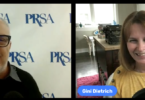On Sept. 21 at 1 p.m. ET, Microsoft’s Bonnie McCracken leads a PRSA webinar titled “Storytelling in the World of AI.” Sign up for this free PRSA member resource here.
In her role as director of innovation and CEO communications at Microsoft, Bonnie McCracken has a pivotal role in shaping the narrative for groundbreaking research and cutting-edge technologies, particularly with the company’s investments in AI.
Here, McCracken talks with PRsay, providing valuable advice for those looking to venture into the AI arena and shedding light on how Microsoft’s own communications team leverages AI tools.

I’ve talked with some PRSA members/communicators who say they feel overwhelmed with the daily barrage of AI-related news and updates. What do you recommend to someone just getting started as an introduction to AI?
I think it’s important to remember that this era of AI, or generative AI, is still very new. It was only 10 months ago when ChatGPT first launched, and since then a lot has happened. A LOT. I agree it can be overwhelming trying to keep up with everything, so my recommendation is don’t. Instead, pick one to two tools you want to try, and once comfortable with those, add on.
For example, practice creating images using Bing Image Creator, or ask Bing Chat to help you summarize a media article. In terms of news, pick a few outlets and reporters you trust who are covering AI frequently, and you’re likely to have a good sense of the most important things happening in the field. A few I recommend, Cade Metz at The New York Times, Kevin Roose and Casey Newton who co-host the Hard Fork podcast, Ina Fried with Axios, and Ethan Mollick, professor at Wharton School of the University of Pennsylvania and creator of the newsletter, One Useful Thing.
How do you think AI differs from how we’ve worked with other new technologies in the past?
AI isn’t new, and in fact, most people have been interacting with AI every day, just not aware of it. For example, facial recognition capabilities that unlock your phone, or show recommendations in your favorite streaming service. What’s different now, with generative AI, is that we are much more aware of our use of AI and can interact with new AI tools to produce content based on our prompts. In terms of adoption of AI, two things stand out to me.
The first is that generative AI is incredibly easy to engage with using natural language. It feels conversational so that you’re able to talk to AI-powered apps and ask for assistance the same way you would if speaking to another human. It may not seem monumental until you try it, but it is game changing. The ability to simply say, “what are the key takeaways from this document?” or “turn these bullets into a work bio for me” and have the AI return results in seconds is quite frankly, amazing. Think about how much time you can save each day if you apply this to a few tasks.
The second thing that differs is the focus on ethics and responsibility so early in the development and adoption of generative AI. In the past we’ve seen technology advancements take hold — from the steam engine to social media — but not until after it is broadly adopted, and issues arise, did people advocate for safety and regulation.
With AI, there are groups across industry, academia and government focused on this. At Microsoft we have hundreds of people thinking about how to develop, deploy and manage AI responsibly, and how to advocate for global regulation to ensure the technology is used for good. We also have a set of programs and processes, such as the Responsible AI Standards we’ve put in place for both our development and to help our customers in their efforts to build AI responsibly.
Many AI-related headlines in the news have taken a more negative slant (inaccuracies, privacy concerns, etc.). What are a few of the more positive aspects of AI for communicators to know?
Being clear-eyed about the risks associated with AI is critical, but it’s equally important to look at the positive opportunities. As a communicator, I’m excited about both the stories I get to tell about the ways Microsoft and our customers are leveraging AI, as well as the ways in which my colleagues and I can leverage AI for the more tedious or time-consuming tasks that pull us away from meaningful work.
For example, think about every time you have writer’s block while crafting a blog post, or find yourself on a short deadline to develop an executive presentation, or you miss a meeting and need to chase down notes and action items. There are AI tools that help with all of this (at Microsoft we call them Copilots). The key is trusting the source and making sure you use enterprise grade solutions to protect your company’s IP.
Can you share an example of how your Microsoft team uses AI?
The Microsoft comms team is experimenting with AI in a few ways, and using this time to both familiarize ourselves with the tools while also thinking about where it can best serve us in our daily tasks. One thing we have created is called Comms Copilot, which is a site that houses a set of AI tools specific to comms professionals. Some of those tools include Social Media Post Generator so that after you finish writing a document, like a blog post, you can paste it into the tool and the AI provides recommended language to use on sites like LinkedIn.
Another tool is Translator, which makes it easy to translate documents into multiple languages, which is incredibly useful as a global company. This is a tool that we’ve built for our team, so while not something broadly available (at least not yet!) there are similar tools available, for example, Bing Chat for Enterprise and ChatGPT for Enterprise (both commercial grade offerings).
What change in skills/AI literacy might be required from comms teams moving forward?
It’s important to assess where your energy is most needed, and what tasks are prohibiting you from spending time on these things. Getting crisp on this will help you determine which AI tools will serve you and your team best.
The second thing I recommend is to get good at your prompts, which is all about getting good at being specific about what you need. A couple blogs that will help you get started include Prompts for communicators using the new AI-powered Bing – The Official Microsoft Blog and The art of the prompt: How to get the best out of generative AI.
[Illustration credit: romana]







